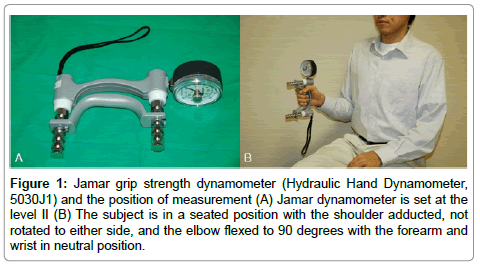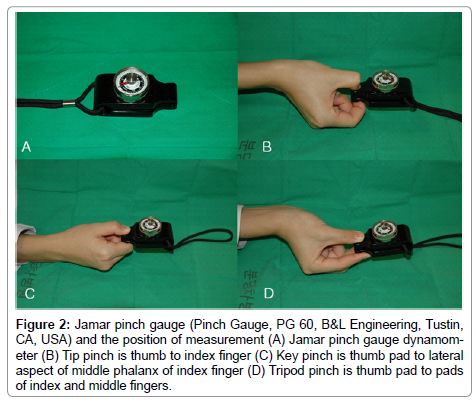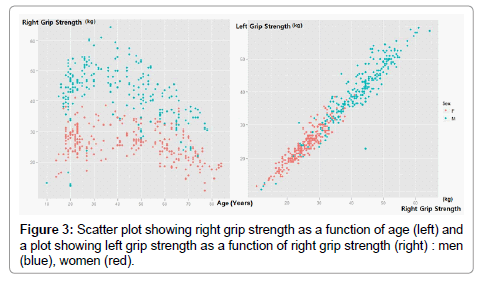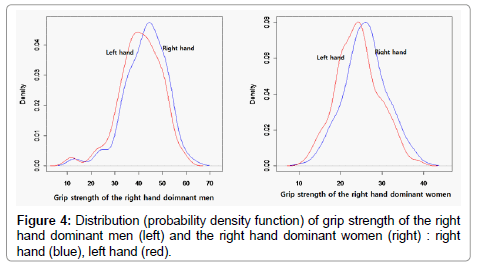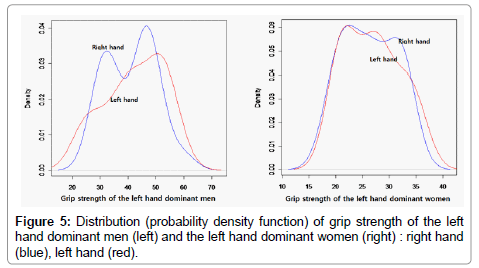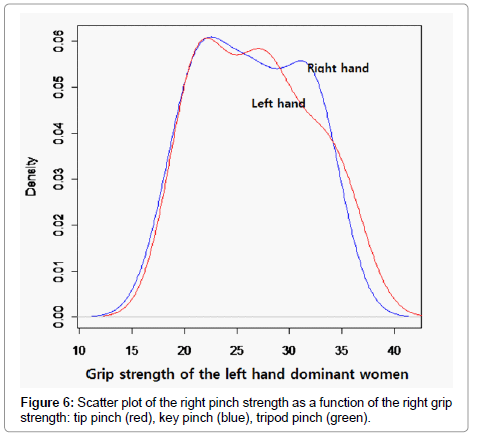Research Article Open Access
Normative Data on Hand Grip Strength
Soo-Hong Han*, Ki-Shik Nam, Yong-Suk Cho and Keun-Jung RyuDepartment of Orthopaedic Surgery, Bundang CHA Hospital, Seongnam College of Medicine, CHA University, Korea
- *Corresponding Author:
- Soo-Hong Han, M.D, Ph.D
Department of Orthopaedic Surgery
CHA Bundang Medical Center, School of Medicine
CHA University, 351 Yatap-dong, Bundang-gu
Seongnam-si, Gyeonggi-do, Korea
Tel: 82 31 780 5289
Fax: 82 31 708 3578
E-mail: hsoohong@hanmail.net
Received date : November 03, 2011; Accepted date : December 04, 2011; Published date : December 10, 2011
Citation: Han SH, Nam KS, Cho YS, Ryu KJ (2011) Normative Data on Hand Grip Strength. J Nov Physiother 1:102. doi:10.4172/2165-7025.1000102
Copyright: © 2011 Han SH, et al. This is an open-access article distributed under the terms of the Creative Commons Attribution License, which permits unrestricted use, distribution, and reproduction in any medium, provided the original author and source are credited.
Visit for more related articles at Journal of Novel Physiotherapies
Introduction
Examination of hand strength is of great importance for identifying impairments, establishing goals, and determining the effectiveness of interventions for patients with hand or upper extremity injuries or disabilities. It is also important for any sport in which the hands are used for catching, throwing or lifting. Hand strength depends on a patient’s age, sex, and hand dominance.
As hand strength varies depending on the measuring method and a patient’s position, reliable and valid evaluation of hand strength is necessary. It appears to be that grip and pinch strength measurements provide an objective index of the function of the hand. Jamar dynamometer and pinch gauge have been found to give the most accurate and acceptable measures of grip and pinch strength respectively. This measuring tools should be performed by having the patient’s in seated position with the shoulder adducted, not rotated to either side, and the elbow flexed to 90 degrees with the forearm and wrist in neutral position, as recommended by the American Society of Hand Therapist.
Materials and Methods
Subjects
This study was approved by the Institutional Review Board at our institution. The study included 515 volunteers older than 10 years, 235 male (45.6%) and 280 female (54.4%). Participants were normal individuals without any diseases or fractures. And we had provided informed consent. Anyone who had restriction of movement in the upper limbs, a history of inflammatory joint disease, for example osteoarthritis or rheumatoid arthritis on any joint of the wrist and hand, or any neurological disorder or injury involving upper extremities by self report were excluded.
Before measuring grip and pinch strength, all 515 individuals were asked to complete a standardized questionnaire regarding demographic information, occupation, current medical status, histories of disease or fracture that were related to hand or upper extremities. A physical examination was performed to see if there were any hand deformities or limitation of finger range of motion. And the findings were recorded on a data-collection sheet by orthopedic surgeons at our institution. Clinical information, grip and pinch strength data were collected and then analyzed retrospectively. This study was approved by the Institutional Review Board at our institution.
The age of the male patients ranged from 10 to 78 years with the mean age of 40 years, and the age of the female patients ranged from 14 to 84 years with the mean age of 44 years. Among 235 male patients, 213 patients (90.6%) were right hand dominant and 22 patients (9.4%) were left hand dominant. Among 280 female patients, 260 patients (92.8%) were right hand dominant and 20 patients (7.2%) were left hand dominant.
Measuring methods
Grip strength was measured using the Jamar hand dynamometer (Hydraulic Hand Dynamometer, 5030J1, Sammons Preston, Bolingbrook, IL, USA). For all subjects, Jamar dynamometer is set at the level II. Three pinch strengths were measured using the Jamar pinch gauge (Pinch Gauge, PG 60, B&L Engineering, Tustin, CA, USA). First, the grip strength of the right and the left hand were measured, subsequently the tip pinch of the right and the left hand were measured. Then key pinch and tripod pinch were measured by the similar methods. We had 1 minute of break between each measure. After 5 minutes of break, grip strength and three types of pinch strength were measured again with the same manner, and the average strengths were obtained respectively. The tip pinch is thumb to index finger, the key pinch is thumb pad to lateral aspect of middle phalanx of index finger, and the tripod pinch is thumb pad to pads of index and middle fingers. The subject is in a seated position with the shoulder adducted, not rotated to either side, and the elbow flexed to 90 degrees with the forearm and wrist in neutral position (Figure 1 & Figure 2). The unit of whole values was kilogram (Kg).
Figure 1: Jamar grip strength dynamometer (Hydraulic Hand Dynamometer, 5030J1) and the position of measurement (A) Jamar dynamometer is set at the level II (B) The subject is in a seated position with the shoulder adducted, not rotated to either side, and the elbow flexed to 90 degrees with the forearm and wrist in neutral position.
Figure 2: Jamar pinch gauge (Pinch Gauge, PG 60, B&L Engineering, Tustin, CA, USA) and the position of measurement (A) Jamar pinch gauge dynamometer (B) Tip pinch is thumb to index finger (C) Key pinch is thumb pad to lateral aspect of middle phalanx of index finger (D) Tripod pinch is thumb pad to pads of index and middle fingers.
Statistical analysis
R program, statistical software (Version 2.12.0, the comprehensive R archive network) was used to image two-dimensional plots, distribution graphs, and to analyze the difference between right hand and left hand strength via paired t-test. Pearson correlation analysis is used to find the most correlated pinch strength with the grip strength. P-values equal to or less than 0.05 were accepted as significant.
Results
Grip strength
Both right and left grip strengths increased with aging and peaked in thirties. Then they declined gradually throughout life for both men and women. It was statistically significant that men’s grip strengths were stronger than women’s (mean 41.77kg in men and 25.20kg in women, p < .05) (Figure 3) Also there was strong positive linear correlation between the right grip strength and the left grip strength in both sexes. (r = .84) (Figure 4)
Pinch strength
For three types of pinch strengths, key pinch was the strongest, followed by tripod pinch and tip pinch.
Tip pinch: Tip pinch increased with aging and peaked in forties in men and peaked in thirties in women (mean 7.90kg in men and 4.96kg in women). Then they declined gradually thereafter.
Key pinch: Data for both sexes demonstrate that key pinch increased with aging and peaked in thirties (mean 10.90kg in men and 7.25kg in women). Men’s key pinch declined gradually thereafter. However women’s key pinch stayed in a plateau of 6.89kg in forties and fifties, and then declined thereafter.
Tripod pinch: Tripod pinch increased with aging and peaked in thirties (mean 9.77kg in men and 6.68kg in women). Then they declined gradually thereafter.
Comparison between the right hand and the left hand
Right hand dominant individuals: Comparisons between the left and right hands of right hand dominant individuals demonstrated that the right hand was stronger than the left hand in all measures that we performed (grip strength and 3 types of pinch strengths) and the differences were statistically significant via paired t-test (p < .05) (Figure 5) The average of the left grip strength was 94.05% of the right grip strength. The average of tip pinch, key pinch, and tripod pinch of the left hand showed 95.24%, 94.31%, and 95.28% of the right hand respectively.
Left hand dominant individuals: Comparisons between the left and right hands of left hand dominant individuals demonstrated that there were no statistically significant differences between the right and the left hand in all measures except tripod pinch. The left hand was stronger than the right hand in. The average of the left tripod pinch was 104.9% of the right hand. It was interesting to see that the grip strength curves have an M-shape in both sexes.
Correlation between grip strength and pinch strength
Pearson correlation analysis was used to identify the relation between grip strength and 3 types of pinch strength. It showed that tip, key and tripod pinch strengths had a positive linear correlation with the grip strength. (Figure 6) Among them, tripod pinch strength was most correlated with the grip strength. (r = .842) (Table 1)
| Grip Strength | Tip Pinch Strength | Key Pinch Strength | Tripod Pinch Strength | |
|---|---|---|---|---|
| Grip Strength | 1.000 | .737 | .842 | .792 |
| Tip Pinch Strength | 1.000 | .768 | .803 | |
| Key Pinch Strength | 1.000 | .807 | ||
| Tripod Pinch Strength | 1.000 |
Table 1: Correlation coefficient between grip and pinch strengths.
Discussion
Grip and pinch strengths are important parameters when evaluating the power of the hand [7-9]. Normative data on grip and pinch strengths are valuable in determining the degree of hand or upper extremity injuries or disabilities either from musculoskeletal or the neurological system of the hand. They can be used in setting surgical or rehabilitation goals or comparing different treatment methods. It is also important for any sport in which the hands are used for catching, throwing or lifting.
There have been various methods for the evaluation of grip and pinch strengths. Jamar hand dynamometer and pinch gauge which were used in this study have been found to be the most widely used equipment. According to Bechtol et al. [1], Carla et al. [4], and Fess [5], grip strength depends on the set level of the handle. Pryce et al. [15] said that it also depends on the examinee’s posture. We set the dynamometer at level II which showing the highest scores in most of the examinees and chose the posture which was recommended by Fess [5]. Nordgren et al. [10] reported that repeated measuring of hand strength more than 2 times can cause fatigue and was not beneficial than a single measurement. Young et al. reported that there was a 12-23% of individual variation in measuring hand strength. So, we measured grip and pinch strengths twice with one minute of break between each measure and the average scores were used in this study.
According to the study on normal Korean adults by Lee et al. in 1995 [11], grip strength peaked in twenties in both sexes (43.9±7.3kg in men and 27.3±1.5kg in women). However our study showed that grip strength peaked in thirties (48.79±6.27kg in men and 28.22±5.83kg in women) This result is similar to the study reported by Massy et al. [12] that the grip strength peaked in forties and fifties. The study on grip and pinch strengths of 628 volunteers in Milwaukee region by Virgil et al. in 1985 [22] showed the grip strength peaked in thirties (52.8kg in men and 32.6kg in female).
Lee et al. [11] reported that all pinch strengths peaked in thirties except key pinch in men (peaked in forties : 8.3±2.3kg) and tip pinch in women (peaked in twenties : 3.9±1.5kg) and tripod pinch was the strongest among them. Our study had a similar result. All pinch strengths peaked in thirties except the tip pinch in men (peaked in forties) and the tripod pinch was the strongest among them. It appears that normal Korean grip and pinch strengths are improved and are closed to the average of Caucasians.
In our study, the number of left and right hand dominant individuals were 42 (8.2%) and 473 (91.2%) respectively. It was very low percentage compared with the Virgil’s study, but high than the study reported by Lee et al. [11] where there were only 2 left hand dominant individuals out of 477).
Bechtol et al. [1] reported that dominant hand was 5-10% stronger than non-dominant hand and can be stronger up to 30%. Peterson et al. [14] reported that dominant hand was 10% stronger than non-dominant hand in right hand dominant individuals and the strengths of right and left hand had no difference in left hand dominant individuals. In our study, grip and pinch strength of right hand were 5-6% stronger than left hand in right hand dominant individuals, which was similar with the Bechtol’s study. And there was no difference between right and left hand in all measures except key pinch in left hand dominant individuals, which was similar with the Peterson’s study. In addition, it is widely assumed that the left hand strength wound be stronger than the right hand in left hand dominant individuals. However our study showed that there were no statistically significant differences between the right and the left hand in all measures except tripod pinch.
Two individuals were reluctant to reveal that they were left handed. Fourteen subjects, although left hand dominant, said that they were taught and forced to use the right hand, and thus could not say which one was dominant. We think the old Korean culture correlating the right side with goodness and the left side with evil can influence some of the left hand dominant individuals having them use non-dominant hands in younger age.
The limitation of this study is that we tried to describe grip and pinch strengths with examinee’s age, sex, hand dominance. However they can be influenced by many factors such as hand size, the forearm circumference, height, weight, occupation, level of physical activities. Multivariate analysis for the explanation of grip and pinch strengths with these factors will be challenging.
Conclusion
The hand strength of normal Koreans have increased compared with the data from some reports in 10 years ago, and they are close to the average strengths of Caucasians. The hand strength of normal Koreans had a characteristic distribution depending on the hand dominance and sex with age. Knowledge of the normative data on hand grip strength will be very helpful for the evaluation and treatment of hand or upper extremities injuries.
References
- Bechtol CO (1954) Grip test; the use of a dynamometer with adjustable hand spacings. J Bone Joint Surg Am 36: 820-824.
- Bland JM, Altman DG (1986) Statistical methods for assessing agreement between two methods of clinical measurement. Lancet 1: 307-310.
- Bohannon RW, Andrews AW (1989) Accuracy of spring and strain gauge hand-held dynamometers. J Orthop Sports PhysTher 10: 323-325.
- Crosby CA, Wehbé MA, Mawr B (1994) Hand strength: normative values. J Hand Surg AM 19: 665-670.
- Fess EE (1992) Grip strength. In: Casanova JS, ed. Clinical assessment recommendations. 2nd ed. Chicago, American Society of Hand Therapists. 41-45.
- Firrell JC, Crain GM (1996) Which setting of the dynamometer provides maximal grip strength? J Hand Surg Am 21: 397-401.
- Hamilton A, Balnave R, Adams R(1994) Grip strength testing reliability. J Hand Ther 7: 163-170.
- Härkönen R, Harju R, Alaranta H (1993) Accuracy of the Jamar dynamometer. J Hand Ther 6: 259-262.
- Incel NA, Ceceli E, Durukan PB, Erdem HR, Yorgancioglu ZR (2002) Grip strength: effect of hand dominance. SingaporeMed J 43: 234-237.
- Lagerström C, Nordgren B (1998) On the reliability and usefulness of methods for grip strength measurement. Scand J Rehabil Med 30: 113-119.
- Lee KS, Woo KJ, Shim JH, Lee GH (1995) The clinical study of grip and pinch strength in normal Korean adult. J Korean OrthopAssoc 30: 1589-1597.
- Massy-Westropp N, Rankin W, Ahern M, Krishnan J, Hearn TC (2004) Measuring grip strength in normal adults:reference ranges and a comparison of electronic and hydraulicinstruments. J Hand Surg 29: 514-519.
- Moon MS, Ok IY, Kim HJ, Im S (1982) The study of pinching type and power. J Korean OrthopAssoc 17: 206-212.
- Petersen P, Petrick M, Connor H, Conklin D (1989) Grip strength and hand dominance: challenging the 10% rule. Am J OccupTher 43: 444-447.
- Pryce JC (1980) The wrist position between neutral and ulnar deviation that facilitates maximum power grip stength. J Biomech 13: 505-511.
- Richards LG (1997) Posture effects on grip strength. Arch Phys Med Rehabil 78: 1154-1156.
- Schmidt RT, Toews JV (1970) Grip strength as measured by the Jamar dynamometer. Arch Phys Med Rehabil 51: 321-327.
- Schreuders TA, Roebroeck M, Van DK, Soeters JN, Hovius SE, et al. (2000) Strength of the intrinsic muscles ofthe hand measured with a hand-held dynamometer: reliabilityin patients with ulnar and median nerve paralysis. J HandSurg Br 25: 560-565.
- Hazelton FT, Smidt GL, Flatt AE, Stephens RI (1975) The influence of wrist position on the force produced by the finger flexors. J Biomech 8: 301-306.
- Teraoka T (1979) Studies on the peculiarity of grip strength in relation to body positions and aging. Kobe J Med Sci 25: 1-17.
- Young VL, Pin P, Kraemer BA, Gould RB, Nemergut L, et al. (1989) Fluctuation in grip and pinch strength amongnormal subjects. J Hand Surg Am 14: 125- 129.
- Mathiowetz V, Kashman N, Volland G, Weber K, Dowe M, et al. (1985) Grip and pinch strength: normative data foradults. Arch Phys Med Rehabil 66: 69- 74.
Relevant Topics
- Electrical stimulation
- High Intensity Exercise
- Muscle Movements
- Musculoskeletal Physical Therapy
- Musculoskeletal Physiotherapy
- Neurophysiotherapy
- Neuroplasticity
- Neuropsychiatric drugs
- Physical Activity
- Physical Fitness
- Physical Medicine
- Physical Therapy
- Precision Rehabilitation
- Scapular Mobilization
- Sleep Disorders
- Sports and Physical Activity
- Sports Physical Therapy
Recommended Journals
Article Tools
Article Usage
- Total views: 14308
- [From(publication date):
December-2011 - Mar 31, 2025] - Breakdown by view type
- HTML page views : 9307
- PDF downloads : 5001

